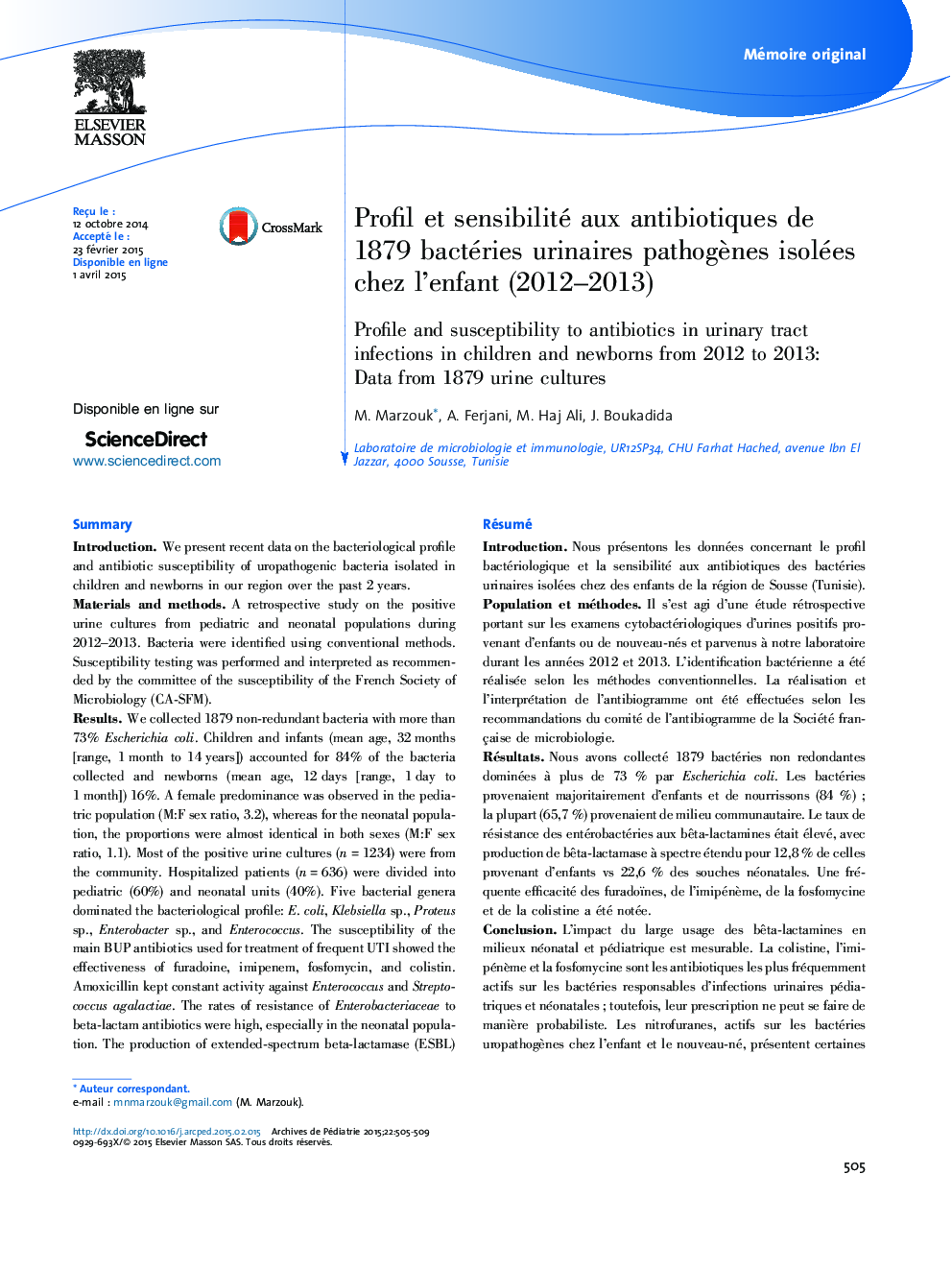| Article ID | Journal | Published Year | Pages | File Type |
|---|---|---|---|---|
| 4145862 | Archives de Pédiatrie | 2015 | 5 Pages |
RésuméIntroductionNous présentons les données concernant le profil bactériologique et la sensibilité aux antibiotiques des bactéries urinaires isolées chez des enfants de la région de Sousse (Tunisie).Population et méthodesIl s’est agi d’une étude rétrospective portant sur les examens cytobactériologiques d’urines positifs provenant d’enfants ou de nouveau-nés et parvenus à notre laboratoire durant les années 2012 et 2013. L’identification bactérienne a été réalisée selon les méthodes conventionnelles. La réalisation et l’interprétation de l’antibiogramme ont été effectuées selon les recommandations du comité de l’antibiogramme de la Société française de microbiologie.RésultatsNous avons collecté 1879 bactéries non redondantes dominées à plus de 73 % par Escherichia coli. Les bactéries provenaient majoritairement d’enfants et de nourrissons (84 %) ; la plupart (65,7 %) provenaient de milieu communautaire. Le taux de résistance des entérobactéries aux bêta-lactamines était élevé, avec production de bêta-lactamase à spectre étendu pour 12,8 % de celles provenant d’enfants vs 22,6 % des souches néonatales. Une fréquente efficacité des furadoïnes, de l’imipénème, de la fosfomycine et de la colistine a été notée.ConclusionL’impact du large usage des bêta-lactamines en milieux néonatal et pédiatrique est mesurable. La colistine, l’imipénème et la fosfomycine sont les antibiotiques les plus fréquemment actifs sur les bactéries responsables d’infections urinaires pédiatriques et néonatales ; toutefois, leur prescription ne peut se faire de manière probabiliste. Les nitrofuranes, actifs sur les bactéries uropathogènes chez l’enfant et le nouveau-né, présentent certaines limites d’utilisation sur ce terrain, et leur indication en cas de pyélonéphrite reste à discuter.
SummaryIntroductionWe present recent data on the bacteriological profile and antibiotic susceptibility of uropathogenic bacteria isolated in children and newborns in our region over the past 2 years.Materials and methodsA retrospective study on the positive urine cultures from pediatric and neonatal populations during 2012–2013. Bacteria were identified using conventional methods. Susceptibility testing was performed and interpreted as recommended by the committee of the susceptibility of the French Society of Microbiology (CA-SFM).ResultsWe collected 1879 non-redundant bacteria with more than 73% Escherichia coli. Children and infants (mean age, 32 months [range, 1 month to 14 years]) accounted for 84% of the bacteria collected and newborns (mean age, 12 days [range, 1 day to 1 month]) 16%. A female predominance was observed in the pediatric population (M:F sex ratio, 3.2), whereas for the neonatal population, the proportions were almost identical in both sexes (M:F sex ratio, 1.1). Most of the positive urine cultures (n = 1234) were from the community. Hospitalized patients (n = 636) were divided into pediatric (60%) and neonatal units (40%). Five bacterial genera dominated the bacteriological profile: E. coli, Klebsiella sp., Proteus sp., Enterobacter sp., and Enterococcus. The susceptibility of the main BUP antibiotics used for treatment of frequent UTI showed the effectiveness of furadoine, imipenem, fosfomycin, and colistin. Amoxicillin kept constant activity against Enterococcus and Streptococcus agalactiae. The rates of resistance of Enterobacteriaceae to beta-lactam antibiotics were high, especially in the neonatal population. The production of extended-spectrum beta-lactamase (ESBL) was noted in 12.8% of pediatric Enterobacteria vs. 22.6% of the neonatal strains. For community Enterobacteriaceae, the activity of beta-lactam antibiotics was limited with 11.2% resistance to third-generation cephalosporins (C3G), including 8.6% ESBL production.ConclusionThe impact of widespread use of beta-lactam antibiotics in neonatal and pediatric environments is felt. Colistin, imipenem, and fosfomycin are the most frequently used antibiotics active against bacteria responsible for neonatal and pediatric UTI; however, they cannot be used as probabilistic treatment. Nitrofurans seem to be active antibiotics on UTI, but they present limits in their use in neonatal and pediatric populations. Their indication in case of pyelonephritis should be discussed.
